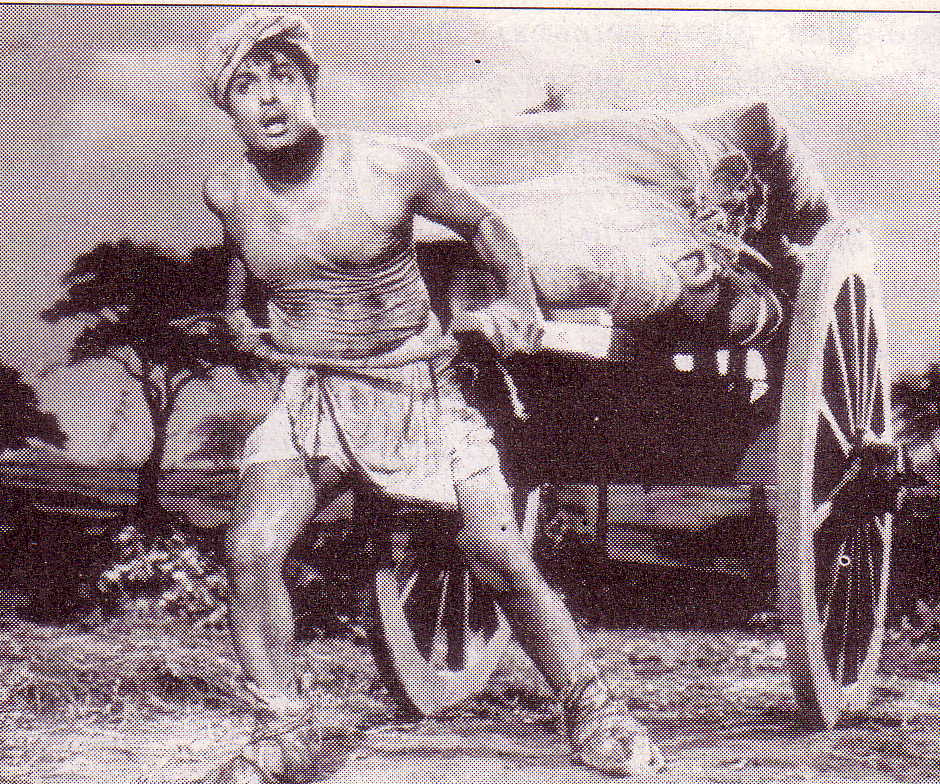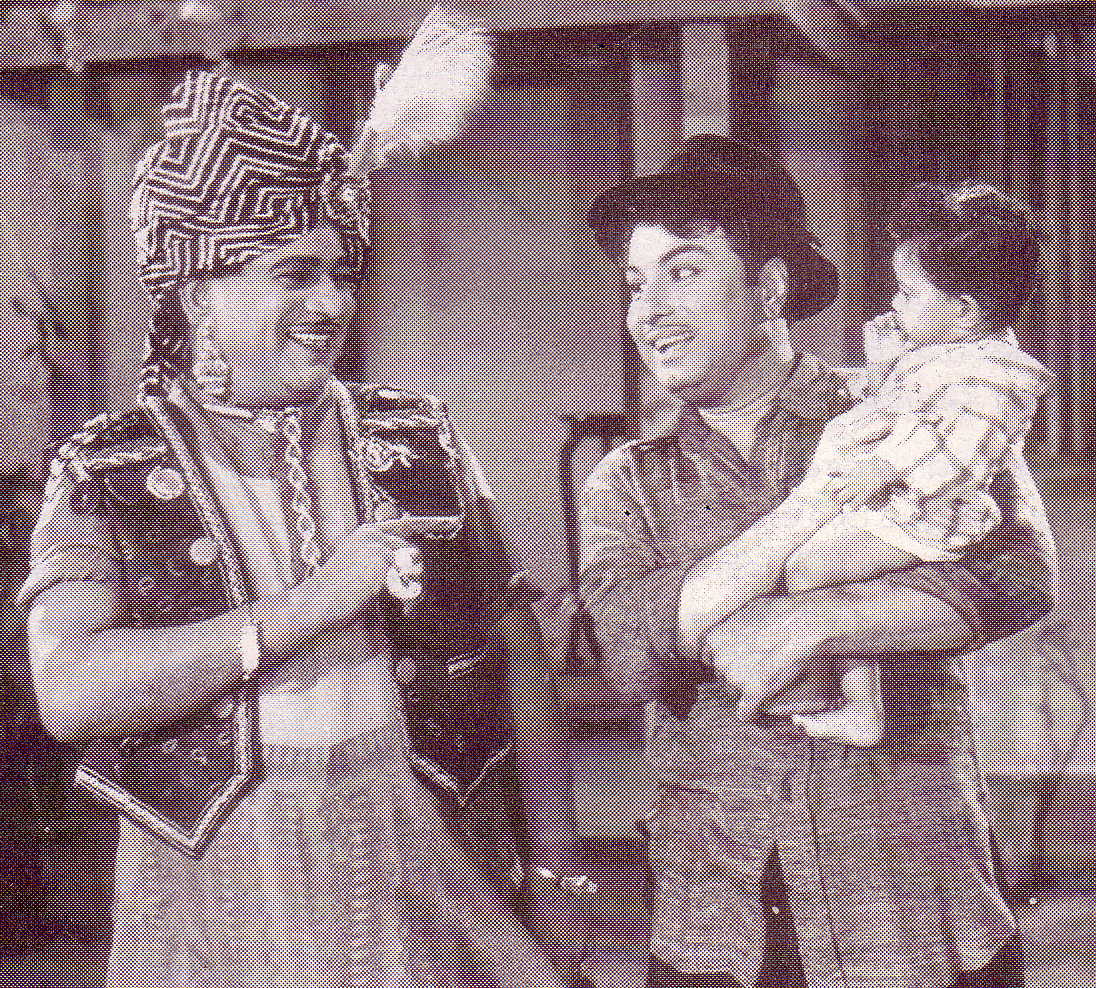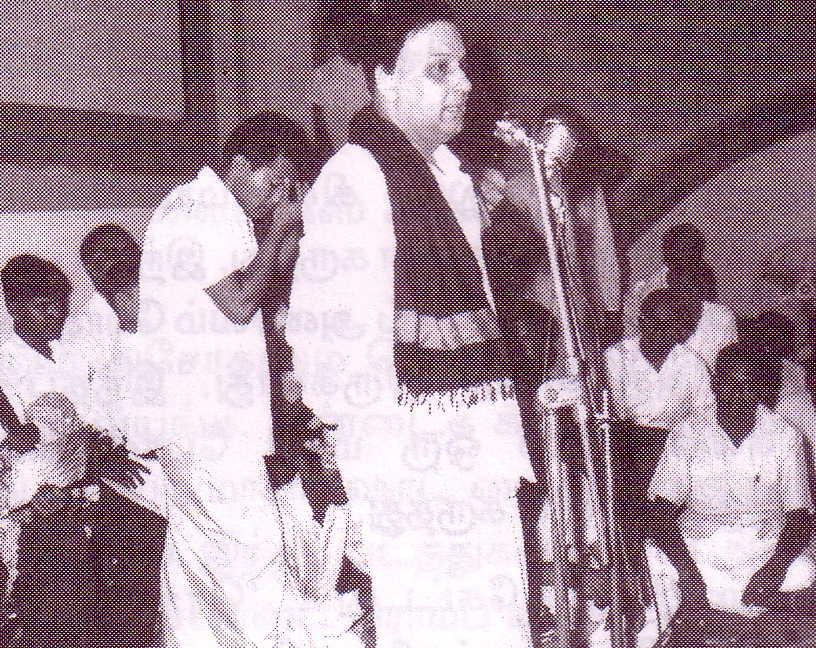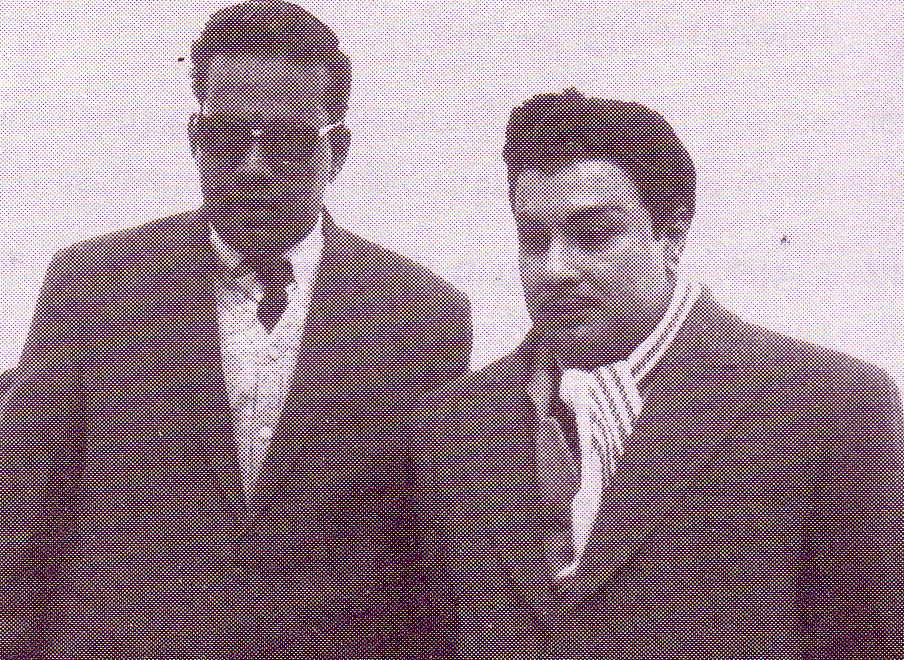by Sachi Sri Kantha, March 16, 2016
A Conflict at the Movie Shooting of TholilaLi (Labourer, 1964)
In the previous chapter, I had inadvertently omitted a 1964 MGR movie, TholilaLi (Labourer), in which M.R. Radha had co-starred with MGR. This was a Devar Films Production. According to the reminiscence of ace script writer Aroor Das, who wrote the script, a conflict broke out between MGR and MRR in the dialogue. Let me give the translated version of what Aroor Das had recorded.
“Originally MGR was a bus company worker in that script. But he was dreaming to become a company owner. To indicate that hope, I had written ‘That’s my tomorrow’s trusting star.’ When I told that, MGR asked me, ‘Why you mention the star in that line?’ I told him the nativity of Jesus Christ story, in which the star was guiding the three Magi from the East. After listening, MGR responded, ‘I do appreciate it. But, when you mention the star, it may refer to the Suwatantra Party Why we should mention it? [Note by Sachi: Right-leaning Suwatantra Party was formed by C. Rajagopalachari in 1959, and star was its symbol.]
‘I didn’t realize it. It’s OK. So, instead of star, why not change it to ‘That’s tomorrow’s rising sun’. [Rising Sun is the symbol of DMK party]
‘Thank you very much’.
That was the script line ‘That’s tomorrow’s rising sun’ which MGR spoke, while the camera was on MRR’s face. That scene was completed. Then, MRR told,
‘Ramachandra! Don’t speak that rising sun phrase directly on my face.’
‘I didn’t say it. Here, the script writer is the one who asked me to say it.’
‘No! You are the one, who made him to change it. I have been listening to what Das was describing on the star origin. That was the optimal line here. You are the one, who had been thinking differently, and confused Das. I don’t care what you say. But, you cannot say it, to my face directly. That’s all.’
As Radha annan was an activist of Dravidar Kazhagam and fan of [E.V.R.] Periyar, he wanted to avoid the Rising Sun phrase of Anna. Immediately, MGR sat on the camera trolley. He changed the settings made by director Thirumugam, so that his lines ‘That’s tomorrow’s Rising Sun’ line reflects on the Lord Muruga’s frame, that was placed in the wall behind MRR. Somewhat pacified, MRR then raised his cigarette-holding hand above to indicate ‘You do it like that’.
Among all the Devar Films movies which I had scripted, that was the first and the last occasion in which MGR took the initiative on his hand.”
This particular episode between MRR and MGR was a premonition for what to come on January 12, 1967. Numerous opinions were floated by ‘experts’ on why MRR had to bring a revolver while visiting MGR and shoot at latter’s residence on that particular day. Was the motive personal, professional or political? Or a combination of all three? The above mentioned episode was also raised at the murder inquiry trial. When producer of TholilaLi movie, Sinnappah Thevar was asked about it, he had somewhat deflected the query with an answer (maybe truthful), “At that time, I was not present at the movie set. I had gone to the adjacent floor.”
This TholilaLi movie was released in September 1964. Recently, Tamil film historian Randor Guy had erroneously commented that this was a successful movie which ran for over 100 days and it proved to be a turning point in MGR’s career (1960s). That it was a financially successful movie for its producer is indeed a fact. But, not a ‘turning point’ movie for MGR, in his self-evaluation! None of his 9 movies released in 1966 failed to place within top 14 of MGR’s choices, as one that made a turning point in his career as a movie hero since 1947.
Before analyzing the tragic event of January 12, 1967, let me offer a summary to the influential political changes in India, movie activities of MGR, as well as political activities of DMK in 1966.
Political Landscape of India in 1966 (A Pre-election Year)
India’s second primeminister Lal Bahadur Shastri (b. 1904) had died in Tashkent (then USSR) on January 11th. Eight days later, on January 19th, Indira Gandhi was elected by a majority vote (355 against 169 for her rival Morarji Desai) as the leader of the Congress Party, and was sworn in as the 3rd prime minister of India on January 24, 1966. Indira Gandhi’s election was attributed to the ‘king-maker’ role played by K. Kamaraj, the then President of the Congress Party. Two other important events occurred in 1966.
In June 1966, based on the advice from International Monetary Fund, Ms. Gandhi devalued the Indian rupee by 36.5 percent, without consulting Kamaraj. Thus, their cordial relations were strained. As Inder Malhotra, an Indira Gandhi biographer had recorded,
“An incensed Kamaraj started blaming himself for having put Indira in power in the first place, muttering: ‘A big man’s daughter, a small man’s mistake.’ At his instance, the Congress Working Committee made history of sorts by passing a resolution denouncing the [Indira] government for its decision on devaluation. If he did not follow this up with a move to dislodge Indira from the prime ministership, it was because Kamaraj knew that such a course just before the General Election would be disastrous for the party as a whole…Publicly, Indira defended devaluation as best she could. But privately she admitted that she had been taken for a ride.”
Subsequently, in November 1966, Hindu chauvinists staged a demonstration in front of parliament calling for an end to cow slaughter. In this violence, Kamaraj escaped narrowly, when his New Delhi residence was attacked by the mob. Congress Party as well as the Opposition parties (including DMK) were preparing for the forthcoming elections scheduled in February 1967.
Indira Gandhi, born on Nov. 19, 1917, was ten months junior to MGR. For 12 years or so (between 1972 and 1984), both MGR and Indira Gandhi played the role of friends and rivals in the political game of ‘give and take’ in Centre-Tamil Nadu State relationship, as well as tackling the Eelam political issue of Sri Lanka. But in 1966, MGR wouldn’t have imagined that he would split the DMK party in 1972 and become the Chief Minister of Tamil Nadu in 1977. He was not even a member of the Tamil Nadu Legislative Assembly then.
MGR’s Movie activities in 1966
In January 1966, MGR reached 49 years. In a year, he would reach 50 (In those days, considered as the ‘wall’ that distinguishes a man from middle age to old age, an equivalent of now-presumed ‘male menopause’.) Even before he reached 50, some Tamil journalists, especially the Thina Thanti daily owned by press baron S.B. Adithan (1905-1981), had begun to tag him with the phrase ‘an old man hero running around nubile girls who were young enough to be his daughters. I provide two period photos nearby, where MGR was seen in movie make up with AVM producer Saravanan, as well as without make up during the felicitation ceremony of the 100th day run for the Anbe Vaa movie. In this photo, one can notice that at the age of 49, MGR had not started wearing his dark sunglasses and the white cap.
Year 1966 also saw an unusual number of 9 MGR movies being released. Previously, 9 MGR movies were released only in 1963. Check the table (Chronological list of MGR movies released 1960-67) which accompanied chapter 26 of this series. The release dates of these 9 movies and the heroine pairing were as follows:
Anbe Vaa (Come here Love; AVM Productions) – B. Saroja Devi, January 14, 1966.
Naan Anaiyittal (If I ordered? Sathya Movies) – B. Saroja Devi, February 4, 1966.
Nadodi (Vagabond, Padmini Pictures) – B. Saroja Devi, April 14, 1966.
Chandrodayam (Rising Moon, Saravana Films) – Jayalalitha, May 27, 1966.
Mugarasi (Luck of Face, Devar Films) – Jayalalitha, August 18, 1966.
Thali Bhagyam (Luck of Thali thread, Varalakshmi Pictures) – B. Saroja Devi, August 27, 1966.
Thani Piravi (Exceptional One, Devar Films) – Jayalalitha, September 16, 1966.
Parakkum Pavai (The Flying Lady, R.R. Pictures) – B. Saroja Devi, November 11, 1966.
Petralthan Pillaiya (Should one give birth to own a child? Sri Muthukumaran Pictures) – B. Saroja Devi, December 9, 1966.
One of MGR’s new found movie muses was Jayalalitha (b. 1948, and then a 17 year old) with whom he clicked superbly in their debut movie, Ayirathil Oruvan (One in a Thousand, 1965). As one could notice from the list of 9 movies, Jayalalitha’s star was in ascendancy with MGR. She was featured as his heroine in three movies, with Saroja Devi (b. 1938) retaining the other six movie slots.
Among the 9 movies, M. Saravanan (the producer of the 1st mentioned, Anbe Vaa movie, an adaptation of ‘Come September’(1961) starring Rock Hudson and Gina Lollobrigida) had recorded his reminiscences in 2005. It was indeed a successful movie for the producers. Saravanan, as the producer, had made a few pertinent observations, which are hard to come by about the production details in MGR movies. First, MGR had given them 72 ‘call sheets’ for shooting this movie and there was hardly any hindrance with him. Secondly, MGR would make suggestions on casting, but would never insist that his wish should be carried out. MGR had wanted comedian K.A. Thangavelu to play the father role in this movie, but the producer had arranged another character actor T.R. Ramachandran for the same role, because latter was a long standing favorite in AVM’s productions. Then, MGR had willingly agreed to the choice of the producers without any murmur. These tidbits from Saravanan somehow falsify the image MGR had among his critics that he would steam-roll his wishes in his movies for his advantage. Thirdly, when shooting fighting scenes, MGR would never allow any outsider in the set. As much as possible, he also avoid shooting any fighting scene in outdoor location. Similarly, he also request that his involvement in any dancing scene should not be filmed in public locations like parks.
Many of MGR’s critics (especially M.S.S. Pandian) had taken these sort of restrictions placed by MGR and extrapolated them to promote their cock-eyed view that MGR was a slave to image consciousness and his star status. But, what has been ignored in such nonsensical criticism is the professionalism MGR was adhering to. A movie shooting is not an entertainment or circus for others to enjoy. As professional sportsmen and sportswomen know well, external distractions do affect the mood and mentality of one’s performance, and MGR had the perfect right and reach to disallow any outsiders when he was performing in front of the camera.
Four of the nine movies were from MGR-circle producers (2 by Sandow Sinnappah Thevar, 1 by T.R. Ramanna, and 1 by R.M. Veerappan). Two movies (Chandrodayam and Nadodi were from producers G.N. Velumani and B.R. Panthulu respectively) who had switched their alliance from Sivaji Ganesan group. It was rumored that the story plot in Chandrodayam movie, where MGR’s character, aptly named Chandran (based on his real life name) was that of a straight reporter, while MRR (with the name Duriyothanan, the main villain in the Maha Bharatha epic) was featured in the villain role of a newspaper publisher of Thina Kavarchi (a play on the name of Thina Thanti) who would do any nasty thing to increase the sales of his newspaper, was targeted on S.B. Adithan, a critic of MGR. The Anbe Vaa movie, produced by reputed AVM company, was the first to be released in 1966.
Two remaining movies Thali Bhagyam and Petralthan Pillaiya caused various problems. Thali Bhagyam, [produced by Telugu director K.B. Nagabhushanam and husband of legendary actress Pasupuleti Kannamba, 1911-1964)] was done by MGR as a gratitude to Kannamba who had died prematurely after the production commenced. Kannamba had been a regular, playing the role of mother in MGR’s ‘Thai’ (Mother) series movies, Thaiku Pin Tharam, Thai Magalukku Kattiya Thali, Thai Sollai Thattathe, and Thaayai Kaatha Thanayan. According to the memoir of Aroor Das, the Thali Bhagyam movie production faced quite a series of pre-release problems. MGR had planned originally that movie to be directed by M.A. Thirumugam, the younger sibling of M.M.A. Sinappah Thevar. But Kannamba’s widower husband Nagabhushanam had adamantly insisted that he should be the director, in addition to being the producer. Due to his lack of management skills, he faced debt from his financiers and eventually was threatened by loss of his house offered as collateral. MGR was the one who eventually negotiated skillfully and saved the face of Kannamba’s husband.
The most problematic movie was Petralthan Pillaiya (a sort of adaptation from Chaplin’s classic The Kid to Tamil Nadu setting, though script writer Aroor Das had not acknowledged it openly), released last in 1966.
Background to the ‘Petralthan Pillaiya’ Movie Production
Translated excerpts of what Aroordas had written in his memoir is provided below to comprehend some background to the January 12th shooting incident at MGR’s residence.
“MGR told me: ‘I have agreed to make a movie for Vasu’s Muthukumaran Pictures. Others who are acting with me are Sarojadevi and Radha annan. We’ve to start the shooting quickly. As Krishnan-Panju are directing, a story with a different angle will be good. When will you provide the story?’
‘I can tell it now’ I replied and completed it in half an hour. He liked it. ‘You can write the complete script for it. What should be the title?’ he asked. I mentioned it, and he was very happy and shook my hands. My title was fitting to the story as well his personal life. [Note by Sachi: It’s very difficult to translate the meaning of Petralthan Pillaiya? Into English. In Tamil, its only two words. But in English, it may be, ‘Should one give birth to own a child?’ or something like that. But still, the subtlety in the Tamil meaning seems lacking. I did check this with one of my literature-mad friend Villa Anandaram too.]
‘You go and meet Radha annan now.’
‘Why should I meet Radha annan?’
‘Listen to me. Go directly to Radha annan. He waits for you.’
Clueless, as MGR requested, I went to Thenampettai Poes Road, where MRR was living. As MGR mentioned Radha annan was there. There were directors Krishnan-Panju and producer Vasu. After seeing me, Radha annan told,
‘Dasu! Come come. I’ve been waiting for you. Just now, Ramachandran called me on phone. (As Radha annan was older to MGR by seven years, he calls him as Ramachandra and in third person singular terms.) He had liked the the story you told him. I also feel happy. This is because, he is guy who wastes so much time on story, story. You also know him. In thirty minutes, you had floored him. Now, I’m not worried. He offered me a cover saying, ‘Here, I give 2,000 rupees. Take it as an advance. Whenever you need money, just ask me. I’ll give.’ With confusion, I took it and by touching it in my front eyes for good luck, and placed it in my shirt.
Sensing my confusion, Radha annan quipped, ‘Are you thinking, what the hell, he is giving advance money? The producer of this movie Vasu is this guy. My long standing friend. As the starting fund, I’m the one who offered 100,000 rupees and a Plymouth car for production. Ramachandran knows all this. Like Devar Films, if you can complete this movie quickly, Vasu will make some profit (money). I’ve told that, directors also will get a cut (from profit) in addition to their pay. Treat it like your own movie. That’s all.’….”
Then, Aroordas continued,
“Though the movie was begun quickly, unlike Devar Films, it couldn’t finish quickly. Sowcar Janaki, T.S. Balaiah, K.A. Thangavelu, S.A. Asokan and a ‘star gang’ acted in that movie. As all the theaters in the Mount Road had been pre-booked for Thai Pongal release movies [in January], somehow they arranged the movie to be released before Thai Pongal and reserved the Star theater in Tiruvallikeni, where only Hindi movies were being screened. Released neither during Deepavali nor in Thai Pongal, this movie was released at the end of the year on December 12, 1966 and became a success. Unlike other MGR movies, there were no fight scenes, but with a heart-warming story line, MGR had shown his acting talent memorably in this Petralthan Pillaiya movie.”
Party Political Activities in Madras State in 1966
In the absence of any primary sources, I have to rely on Karunanidhi’s autobiography (chapter 126) for details. This autobiography first published in 1975 (and written after MGR was thrown out by him from DMK party in 1972) is somewhat biased against MGR. Karunanidhi had described (1) his script-writing activities in three movies released in 1966, both starring S.S. Rajendran; Avan Pithana (Was He Mad?), Marakka Mudiyuma (Can’t Forget) and Mani Magudam (Jeweled Crown); (2) the election for the South Indian Artistes Federation (Nadigar Sangam) in which S.S. Rajendran won, against comedian actor ‘Kaka’ Radhakrishnan. Karunanidhi castigated MGR strongly for offering his support to Radhakrishnan, and not to Rajendran; (3) DMK party leader Anna escaped an assassination attempt from Congress Party ruffians during his election campaign at Kovai district. (4) The 4th General Conference of DMK held from Dec. 29, 1966 at Virugambakkam (Chennai). Karunanidhi mentions that actor M.R.R. Vasu (eldest son of MRR) participated in the procession, while riding in a horse! and offers self-congratulation for collecting 110,000 rupees for party election funds and how Anna had appreciated such an effort in front of all. (5) His anguish on hearing the mob attack on Kamaraj’s house in New Delhi.
There is something duplicitous in Karunanidhi’s writing. No specific mention is made about the January 12, 1967 MGR-MRR shooting incident, between chapter 126 and 127! In chapter 127 with the caption ‘Amidst assassins in Kottur’, he had described a scene where he was targeted for an attack on February 14, 1967. He also mentions that, he was repeatedly targeted for an attack by his political enemies on February 20, 1967 at Kadalur. What is duplicitous is that, he had castigated MGR strongly for working against DMK candidate Rajendran in the Nadigar Sangam (Actor’s Federation) voting for working against party’s candidate. But, when MGR (a pillar in DMK party) was shot he hardly made any reference to this incident in his autobiography, while expressing his anguish to the New Delhi attack on the residence of Kamaraj (a political rival).
A sample of Karunanidhi’s accusation on MGR’s deeds for the party is as follows: “Did he participate in any demonstrations and confrontations organized by the party? Did he receive any sacrificial wounds on behalf of the party? Was his life threatened for not taking off the ‘black shirt’ in such confrontations? Was he threatened during the 1965 anti-Hindi demonstration by the Congress Party rulers for not hanging the flag at half-mast at his residence? Nothing at all. Without any sacrificial stamps on his behalf, he had placed himself at the front ranks of the party. The only badge he can boast of was that while thousands of party’s workers were sacrificing their blood and lives during the 1965 ‘just-war’ [Ara-Por, was the Tamil word Karunanidhi had used], he wasn’t scared to act in love scenes at Goa beach! That ‘rare man’ Mr. M.G. Ramachandran…”
Of course, Karunanidhi’s facts cannot be challenged. But, he had presented only one angle of the story. Then, MGR was the leading hero in Tamil movies and not a full time politician; he did contribute his share to the party propaganda among the illiterates, via the movies. As presented earlier, even introducing the DMK party symbol ‘rising sun’ in his dialogue (to the ire of MRR!) and songs was indeed a contribution. One well known song sung by T.M. Soundararajan in the popular ‘Anbe Vaa’ movie, written by poet Vaali, ‘Puthiya Vaanam Puthiya Bhumi’ [New Sky, New Land] delicately introduced the party symbol, ‘Udaya Sooriyanin Paarvaiyile – Ulagam Vizhithukonda VeLaiyile, Imayathil irukkum kuLir kaatru Ithayathai thodukirathu’ [While rising sun shines, the world will become aware, The cool wind from Himalaya will touch the heart] in that pre-election year. While Karunanidhi himself had made so many flip flops in his political career in the past half century by not adhering to the originally established principles of his party, and while MGR (the lip-synching actor, who was thrown out of the DMK party), singer, lyricist and song arranger (music director M.S. Viswanathan) had passed into eternity, this hit song still comes alive in the digital, Youtube era, still promoting DMK party symbol! Action for this song was shot in Shimla, Himachal Pradesh.
According to Karunanidhi’s autobiography, politically motivated assassination attempts had been made on the lives of Anna in November 1966 and on him in February 1967. And, MRR’s shooting of MGR occurred in between in January 1967. Couldn’t this assassination attempt be also a politically motivated one? Opinion is divided. Some infer that MRR’s shooting was personal and/or acting profession-related. Some tend to believe that MRR acted as a proxy to MGR’s political rivals who wanted to get rid of a popular DMK vote-catcher before the 1967 General Election.
Cited Sources
Aroordoss: Cinema Nijamum Nizhalum (Cinema – Real and Shadow) Memoir, Arunthathi Nilayam, Chennai, 2001, pp. 275-276.
Arurdoss: Kottaiyum Kodambakkamum (Fort and Kodambakkam) Memoir, Vikatan Prasuram, 2nd ed., 2006, pp. 130-132.
Randor Guy: Blast from the Past Chandhrodhayam (1966). The Hindu (Chennai), Jan. 9, 2016.
Randor Guy: Blast from the Past Thozhilaali (1964). The Hindu (Chennai), Jan. 30, 2016.
Robert L. Hardgrave Jr. When Stars displace the Gods: The Folk Culture of Cinema in Tamil Nadu, In: Essays in the Political Sociology of South India, Usha Publishers, New Delhi, 1979, pp. 92-124.
Kannan R: Anna – The Life and Times of C.N. Annadurai, Penguin Books, New Delhi, 2010, pp. 298-301, 305.
Karunanidhi, M: Nenjukku Neethi (Justice for the Heart) – autobiography, vol.1, 1st edition, 1975, Thinamani Kathir, Chennai.
Inder Malhotra: Indira Gandhi – A Personal and Political Biography, Coronet Books, Sevenoaks, Kent, 1989, p. 99.
MGR: Naan Yaen Piranthaen? (Why I was Born?) – autobiography, part 2, Kannadhasan Pathippagam, Chennai, 2014, pp. 1248-1254.
Pandian M.S.S: The Image Trap: M.G. Ramachandran in Film and Politics, SAGE Publications, New Delhi, 1992, pp. 95-96.
Saravanan M: AVM 60 – Cinema, Rajarajan Pathipagam, Chennai, 2005, pp. 159-179.




The words of MRR “…He had liked the story you told him. I also feel happy. This is because, he is guy who wastes so much time on story, story. You also know him. In thirty minutes, you had floored him. Now, I’m not worried…” speaks volumes about MGR’s attitude towards the story. That is why still his movies are spellbinding.
Sir, you are doing an amazing contribution to the world by writing this wonderful series on ‘Makkal Thilagam, Puratchi Thalaivar M.G.R’. Thank you very much.